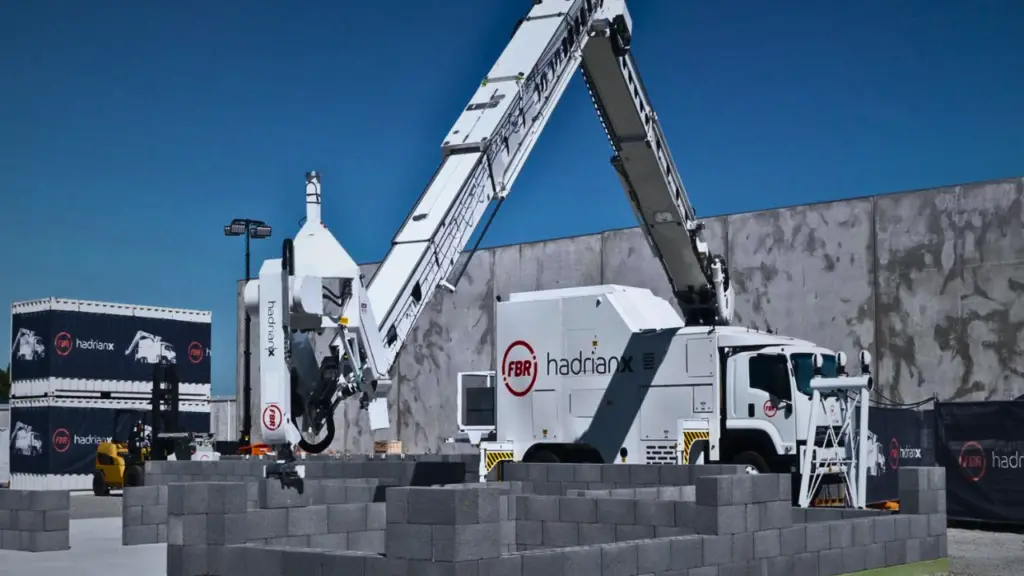Brick’s Timeless Legacy
Brick is one of the oldest building materials known to humanity, with sun-hardened varieties dating back to 7000 BC and the first kiln-fired blocks appearing around 3500 BC.
This enduring material has been used to create everything from modern abstract shapes to stunning arches. The traditional method of laying bricks—spreading mortar, positioning a brick, and smoothing out excess mortar with a trowel—has remained largely unchanged for millennia.

Enter Hadrian X: A Technological Marvel
An Australian construction-technology firm, FBR (formerly Fastbrick Robotics), is revolutionizing this ancient craft with its innovative bricklaying robot, Hadrian X. Named after the wall-building Roman emperor, Hadrian X can complete its tasks without human intervention, blending tradition with cutting-edge technology.
Benefits of the Bricklaying Robot
Efficiency and Speed
Hadrian X offers numerous advantages that could transform the construction industry. By automating bricklaying, this technology addresses the global housing shortage.
“There aren’t enough people to build houses fast enough,” says Steve Pierz, Chief Innovation Officer at FBR. Automating the construction process is a viable solution for mass construction.
Disaster Recovery
Pierz envisions fleets of Hadrian X robots rapidly constructing housing in disaster-stricken areas, providing swift and efficient rebuilding efforts.
Precision and Cost-Effectiveness
Hadrian X’s precision not only improves efficiency but also reduces costs. The robot promotes a lean-construction approach, increasing productivity while minimizing waste. “We take a single source of data and from there, we’ll know the number of blocks and the amount of adhesive required given the lay pattern,” explains Simon Amos, Director of Construction Technologies at FBR. This upfront information ensures minimal waste.
Sustainability
By optimizing materials and reducing waste, Hadrian X contributes to more sustainable construction practices, aligning with global environmental goals.
How Hadrian X Works
Advanced Systems Integration
Hadrian X resembles a truck-mounted crane but is built from sophisticated components: a control system, a block-delivery system, and a dynamic stabilization system. Together, these components bring Hadrian X to life. Once blocks are loaded, the robot identifies each one and determines its placement. It can cut blocks into various sizes as needed and store them for later use. The blocks are then transported via a boom system to a layhead, which positions them according to a pre-programmed pattern.
Dynamic Stabilization
“The layhead is where the magic happens,” says Pierz. Despite wind and vibrations, the layhead compensates hundreds of times per second to maintain precise block placement.
The Brains and Hardware Behind Hadrian X
Development Journey
Hadrian X’s development has spanned over a decade. The concept of a dynamically stabilized robot was first conceived in 1994, but it wasn’t until 2005 that FBR’s Founder and Chief Technical Officer, Mark Pivac, created the initial prototype. The global financial crisis in 2008 delayed the project, but it resumed in 2014 amidst a booming construction industry and a labor shortage.
Advanced Control System
The robot’s control system is its “brain.” Using Cartesian coordinates and parametric design, FBR’s proprietary software transforms a CAD-modeled wall structure into brick metadata. This metadata includes every brick’s coordinates, allowing the software to create a precise nesting pattern. An algorithm then determines the optimal brick layout, considering the size of the layhead and block grip.
Optimized Blocks
FBR designed its own blocks to suit the robot, optimizing for consistent wall thickness and maximizing lay rate. These blocks are 12 times larger than standard bricks, enabling Hadrian X to lay one block every 45 to 55 seconds. The robot uses a special adhesive that bonds faster and stronger than traditional mortar.
Rigorous Testing and Resilience

Dynamic Stability Testing
FBR’s Pivac used his expertise in aeronautics, mechanical engineering, robotics, and mathematics to develop the patented Dynamic Stabilization Technology (DST). DST ensures accurate block positioning over large distances, counteracting environmental factors like wind and vibration. This stability allows Hadrian X to be mounted on various bases, including barges and cranes, for versatile bricklaying applications.
Field Testing
Hadrian X underwent extensive testing to ensure resilience. Its milestone build occurred in November 2018, completing a 180-square-meter home in three days. Outdoor testing during Australia’s hot summer in February 2019 provided valuable data on environmental influences, challenging the robot in aggressive conditions.
Global Partnerships and Future Prospects
International Collaborations
FBR is preparing for Hadrian X’s global future. The company has agreements with GP Vivienda in Mexico and the Kingdom of Saudi Arabia to explore pilot programs and projects. A partnership with Wienerberger, an Austrian clay-block manufacturer, aims to create optimized clay blocks for Hadrian X and plan a pilot project in Europe.
Local Initiatives
In Australia, FBR has partnered with Brickworks to offer “Wall as a Service,” supplying concrete masonry blocks for residential projects.
Industry Disruption
Pierz believes Hadrian X has the potential to transform the construction industry. “Disruption only comes when you look at your industry from a completely different angle,” he says. Embracing new technologies is crucial to avoid being left behind.



